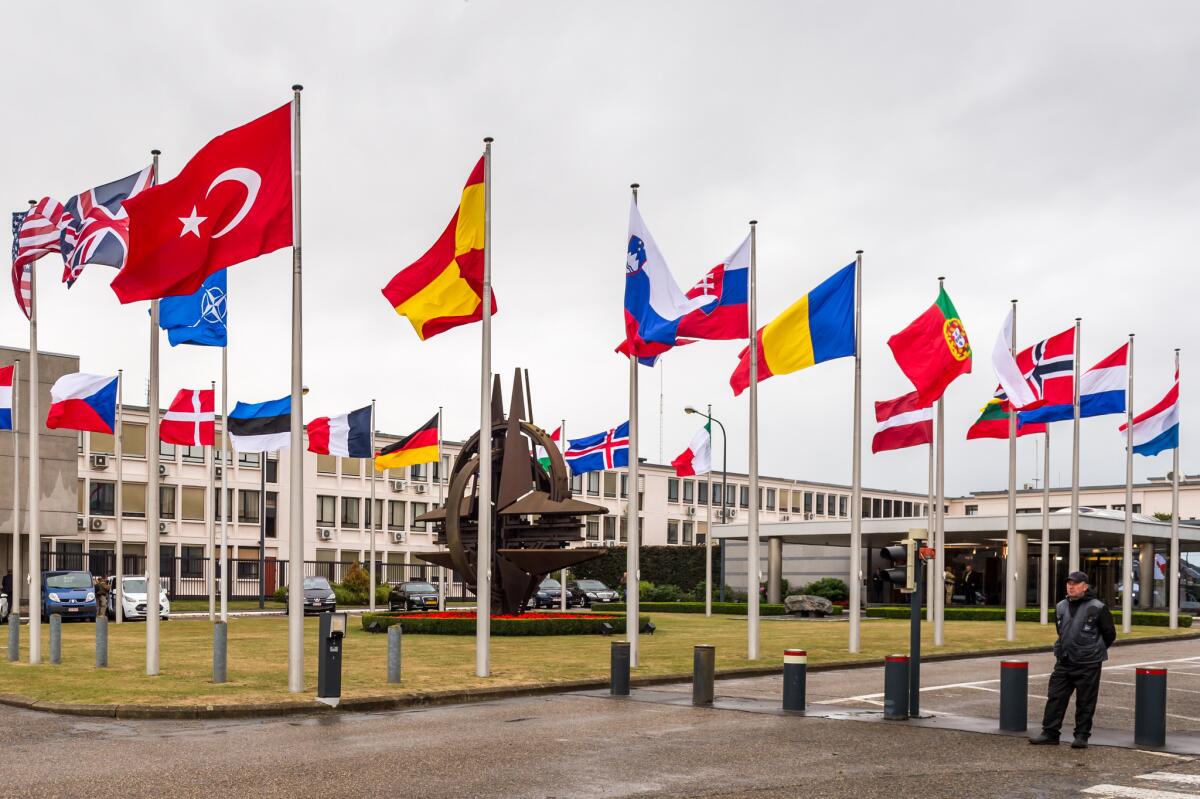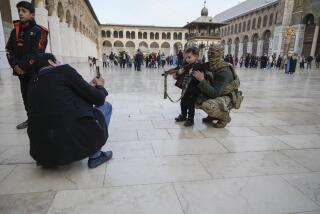Who will provide the muscle for a Syrian ‘Islamic State-free zone’?

Flags of the NATO nations fly outside the alliance’s headquarters in Brussels on July 28 as ambassadors of the 28 member states meet in emergency session to discuss Turkey’s response to recent terrorist strikes.
- Share via
Reporting from Beirut — As the U.S. and Turkey begin clearing Islamic State fighters from Syria’s northwestern border, their ambitious mission raises a new set of troubling questions, chief among them: Who will provide the military muscle to oust the extremists and protect civilians sheltering in the new buffer zone?
The fracturing of Syria’s opposition suggests that the border region could fall quickly under the sway of Syrian rebels linked to Al Qaeda, insurgents nominally opposed to Islamic State but who share much of the group’s radical ideology.
At the same time, Turkey’s determination to defang forces from its own opposition by excluding them from the new border zone could undermine the very fighters — Kurdish rebel units — who until now have been the most effective ground forces battling Islamic State.
The issue has profound consequences not only for the fight against Islamic State but for Turkey’s political future as the country partners with the U.S. against the fundamentalist militants who now control large areas of Iraq and Syria and have established cells in Turkey as well.
The new buffer zone, stretching west 68 miles along the Syrian-Turkish border from the Euphrates, and 20 miles deep into Syria, would in theory scatter militants from the strategic area, stanch Islamic State’s flow of recruits and supplies from Turkish territory, and perhaps serve as a haven for multitudes of Syrian refugees.
As details have begun to surface, however, it has become clear that the still-evolving plan for an “Islamic State-free zone” is a complex and delicate undertaking that faces many obstacles and could be unworkable, or have calamitous unforeseen consequences. Some fear that the scheme could make things worse, escalating the Syrian conflict and refugee crisis.
The concept also poses a clear danger of U.S. mission creep, more direct U.S. involvement in the pulverizing Syrian war and the alienation of a key ally, the Syrian Kurdish militia forces.
“The only viable non-state anti-Islamic State options are the Kurdish fighters, whom the Turks want to expel from that zone,” noted Jeffrey Bale, a professor of counter-terrorism and religious extremism at the Middlebury Institute of International Studies at Monterey.
An underlying tension stems from Washington’s and Ankara’s conflicting priorities: While the Obama administration is focused on destroying Islamic State, Turkey seeks to curb Kurdish expansion and topple the government of Syrian President Bashar Assad.
Obama administration officials, though calling for Assad to step down, view a precipitous collapse in Damascus as potentially catastrophic, possibly ushering in a radical Islamist government, a round of ethnic cleansing and vast new refugee flows.
Still, bowing to Turkey’s persistent demands for some form of buffer zone in northern Syria has apparently secured several cherished U.S. objectives: access to strategic bases and air space in southern Turkey, and some degree of bolstered commitment from a long-reluctant Ankara in the fight against Islamic State.
In recent months, Turkish officials have viewed with alarm the Kurdish militia thrusts along their southern flank, facilitated by hundreds of U.S. airstrikes. Syrian Kurds now control strategic crossings like Kobani and Tal Abyad that Islamic State used to funnel in weapons and fighters.
As currently envisioned, the shielded territory would include several Islamic State strongholds, including towns within 10 miles of Aleppo, Syria’s second-largest city split for more than three years between rebel and government forces.
Air power will not be enough to dislodge Islamic State, as has already been evident elsewhere in Syria and Iraq. Both Turkey and the United States insist they will not commit ground troops.
Turkey is determined to bar Syrian Kurdish militiamen, whom it regards as proxies for its longtime adversary, the Kurdistan Workers Party, or PKK, which has waged a three-decade war against the Turkish state. A two-year cease-fire between the Turks and the PKK has unraveled in recent days, further muddying the battlefield picture in the volatile borderlands.
U.S. and Turkish officials say the ground battle will be left to “moderate” elements of the Syrian opposition, including the remnants of the Free Syrian Army.
But hard-core Islamist groups like Al Qaeda-affiliated Al Nusra Front, or Jabhat al Nusra, and Ahrar al Sham have come to dominate the opposition in the northwest. U.S. officials have conceded that they were able to find only 60 or so “moderate” recruits for a new, much-hyped train-and-equip program on Turkish soil.
West-backed rebels in northwest Syria acknowledge taking a secondary role and working in tandem with Al Nusra and its allies.
U.S. officials insist Al Qaeda will not benefit from the plan. “Nothing protects Al Nusra from the long arm of the United States of America,” State Department spokesman John Kirby assured reporters Monday. But with the Kurds excluded at the Turks’ insistence, it is unclear who else will carry the load in any ground operations.
“There is no viable ‘moderate Syrian opposition’ with the military capabilities to resist” Islamic State, Bale said. “Anyone who thinks that the Jabhat al Nusra is fundamentally different from the Islamic State with respect to its jihadist Salafist ideology — and thus, its totalitarian, theocratic, Islamic supremacist agenda — is delusional.”
Along with ground forces to drive out Islamic State, the proposed safe zone would require the presence of a substantial police and security presence to protect the civilian population, potentially including resettled refugees.
“I would be surprised if we could have enough moderate Syrian opposition forces capable of carrying out these tasks while still fighting a civil war,” said Christopher Chivvis, associate director of Rand Corp.’s International Security and Defense Policy Center.
And without reliable defenses, the safe area would be doomed to failure, he said.
“Everyone should have in mind the experience of UNPROFOR in Bosnia,” Chivvis said of the early 1990s U.N. protection force mission that deployed tens of thousands of peacekeepers with no authorization to use force. The foreign soldiers watched helplessly as thousands of civilians were slaughtered in the so-called haven of Srebrenica.
“It was a well-intentioned effort to provide humanitarian relief in an ongoing civil war that resulted in abject failure and led eventually to our intervention in Bosnia.”
In another potential snag, Washington insists that the secure space in Syria will not amount to a formal no-fly zone that could expose the U.S.-led coalition’s aircraft to Syria’s considerable air defenses. Though not labeled a no-fly zone, that is in effect what it would be.
To date, U.S. airstrikes in Syria have been concentrated in the north and east of Syria where government forces have withdrawn. Aleppo province, however, remains a major battleground, meaning U.S. warplanes could run a greater risk of conflict with Syrian forces.
U.S. officials said in a teleconference with reporters Tuesday that the American-led coalition has already launched airstrikes against Islamic State positions in the vicinity of the proposed safe zone. The officials, who were not authorized to speak publicly on the matter, said the strikes were part of an operation to eradicate the fighters from the “last stretch” of Syrian border between the towns of Jarabulus and Azaz.
A retrenchment of government forces and air power could facilitate the advance of Al Qaeda-linked fighters on various fronts, including into the government-held side of Aleppo, home to about 2 million people. Thousands of Christians live in daily fear of extremists overrunning the city. Aleppo’s prospective fall to militant Islamists could trigger a massive new wave of refugees, exactly the kind of result that the safe zone is meant to avert.
Experts warn of the unintended consequences of experimental projects in conflict zones, even if the intentions are mainly humanitarian.
“The mistake we kept making in the Balkans and Somalia and other places was believing that what we thought of as neutral humanitarian efforts were perceived that way by the parties to the conflict, when these humanitarian efforts prevented some of them from achieving their war aims,” said Kori Schake, a National Security Council member in the George W. Bush administration, now a fellow at the Hoover Institution think tank.
“What will play out in this safe zone along the Turkish border is a whole bunch of unanticipated events.”
McDonnell reported from Beirut and Williams from Los Angeles. Times staff writer W. J. Hennigan in Washington contributed to this report.
Follow @cjwilliamslat for the latest international news 24/7
NEWSLETTER: Get the day’s top headlines from Times Editor Davan Maharaj >>
ALSO:
Turkey and the U.S. join forces in fight for ‘Islamic State-free zone’ in Syria
Syria’s Assad admits setbacks, insists he won’t lose civil war
With airstrikes, Turkey joins regional clashes
More to Read
Sign up for Essential California
The most important California stories and recommendations in your inbox every morning.
You may occasionally receive promotional content from the Los Angeles Times.











